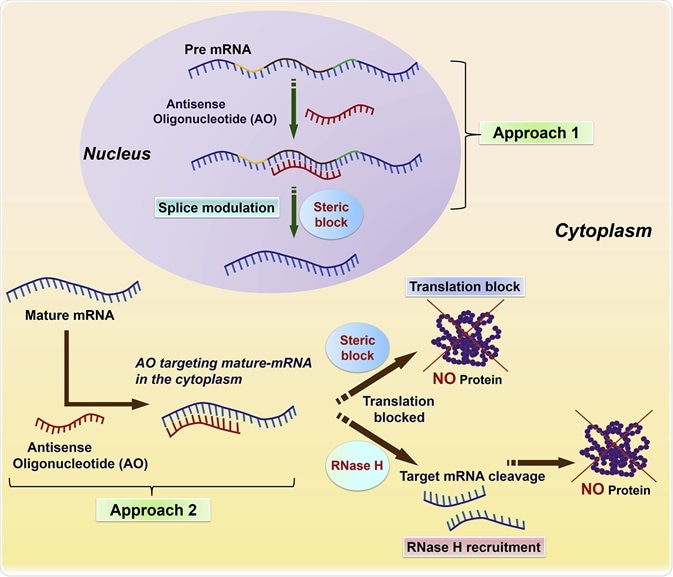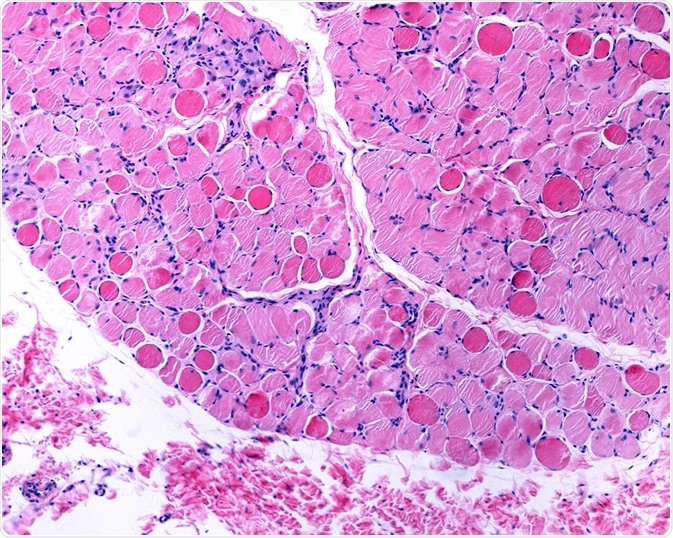Antisense technology is a new and promising tool for controlling gene expression in a cell. Using synthetic antisense oligonucleotides, it targets genes at the level of mRNA, rather than DNA, and prevents them from producing proteins.

Image Credit: https://www.cell.com/molecular-therapy-family/nucleic-acids/fulltext/S2162-2531(18)30301-9
This rapid, specific, and high throughput technique has enormous potential in research, as well as treating a range of diseases including cancer, viral infections, and cardiovascular, neurological, and ocular diseases.
Several antisense therapies have been approved and are currently being utilized to treat these diseases clinically. However, the potential therapeutic benefits for many other illnesses makes this technology so exciting.
The mechanisms of antisense technology
Antisense oligonucleotides are synthetic, short, single-stranded nucleotides that inhibit the transcription of target genes. They do this by binding with high specificity to complementary mRNA sequences by Watson and Crick base pairing, forming a dimer. This occurs in the same precise manner as in DNA replication and RNA transcription.
Once bound to the mRNA, the antisense oligonucleotides halt it from advancing to protein synthesis by preventing access to the ribosome. They achieve this by simply occupying the mRNA protein, preventing translation and splicing; or by targeting the dimer for degradation by ribonuclease H1. The latter method is commonly utilized clinically by various antisense therapeutics.
Technical problems in antisense technology
Early designs of antisense oligonucleotides had little therapeutic effect due to several difficulties in their mRNA inhibition. These issues included inadequate tissue distribution and cell permeability, as well as low specificity to their mRNA targets.
High specificity is necessary to prevent toxicity by inhibition of undesired proteins in fundamental cellular processes. A short half-life was another problem, meaning they were not able to suppress gene expression for significant periods.
These issues have been overcome in many of the antisense therapeutics that have been approved for clinical use today. Chemical modifications to the oligonucleotides have improved their stability and increased their resistance to ribonuclease digestion.
One example of modifications includes designing lipid conjugates to improve incorporation into the plasma membrane to enter the cell. Another example includes replacing phosphates in the backbone, with phosphorothioates. This has shown to improve the stability and bioavailability of oligonucleotides by reducing their sensitivity to endonucleases.
Applications of antisense technology in vitro
In vitro applications of antisense technology have been applied successfully in research to understand the function of genes. By studying the knock-on effects of translation inhibition, scientists can determine the cellular process that a protein is involved in.
These ‘knock-down’ gene experiments have been widely used in tissue culture, Xenopus, and mouse models.
In comparison to reliable techniques that knock-down the gene directly, antisense methods are often more immediate and do not disrupt the regulatory DNA areas.
Therapeutic applications of antisense technology
Antisense technology has widespread potential in the treatment of various diseases including cancer, viral infections, cardiovascular, neurological, immunological, and ocular diseases, although many of the drugs have yet to be approved and are still in the clinical trial stage.
There has been an FDA approved drug designed to inhibit the mRNA translation of human cytomegalovirus. This antiviral agent works by suppressing the production of viral proteins to prevent the onset of cytomegalovirus retinitis. It has been utilized to treat the disease in immunocompromised patients including those with AIDS. This technology has the potential to inhibit the synthesis of a wide variety of viral infections.
One of the most widely anticipated uses for antisense technology is in gene therapy. The introduction of antisense oligonucleotide encoding genes into the host cell DNA via vectors would allow long term inhibition of target proteins.
Another promising application of these antisense oligonucleotides is in the treatment of cancer. The potential to inhibit gene expression of oncogenes could potentially reduce tumor growth and correct the abnormal gene expression of cellular processes in tumors. However, the capacity of suitable carriers to deliver sufficient doses in tumors is limiting and has slowed advances in cancer treatments. Many clinical trials are currently ongoing.
Several other antisense drugs have been approved for their use clinically. For example, an antisense oligonucleotide inhibitor of an apo-B protein is used to treat Familial Homozygous Hypercholesterolaemia. Apo-B is an essential structural component of lipoproteins. By halting the translation of apo-B, their plasma concentrations decrease, leading to a reduced risk of coronary heart disease.
Another group of antisense therapies called Morpholino can be utilized to treat specific subtypes of Duchenne Muscular Dystrophy depending on the particular gene mutation of the disease.
For example, one drug can be used to treat around 14% of cases. It binds to the dystrophin mRNA and triggers exon skipping of exon 51. This modification to the transcript restores the dysfunction reading frame in this muscular dystrophy subtype, allowing the production of functional dystrophin protein.
Antisense technology has provided treatments to otherwise untreatable diseases and it shows great potential for the treatment of a wide number of others. With modifications to antisense oligonucleotides, their stability, specificity, efficacy, and half-life have greatly increased. This, as well as ongoing clinical trials, shows great promise for the future of this exciting expanding field!

Image Credit: Jose Luis Calvo/Shutterstock.com
Sources
- Di Fusco, D., Dinallo, V., Marafini, I., Figliuzzi, M., Romano, B., and Monteleone, G., 2019. Antisense Oligonucleotide: Basic Concepts and Therapeutic Application in Inflammatory Bowel Disease. Frontiers in Pharmacology, 10.
- Lee, R., Crosby, J., Baker, B., Graham, M., and Crooke, R., 2013. Antisense Technology: An Emerging Platform for Cardiovascular Disease Therapeutics. Journal of Cardiovascular Translational Research, 6(6), pp.969-980.
- Re, R., 2000. The Application of Antisense Technology to Medicine. Ochsner J., 2(4), pp.233-236.
- Sharad, S., 2019. Antisense Therapy: An Overview. Antisense Therapy, [online] Available at: Intechopen [Accessed 13 October 2020].
Further Reading
Last Updated: Nov 12, 2020